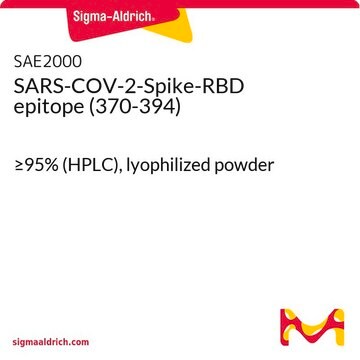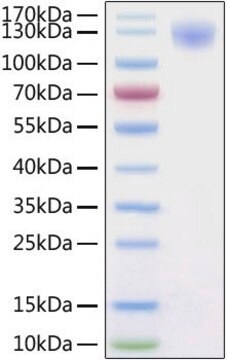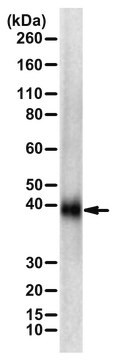SAE2002
SARS-COV-2-Spike-RBD epitope (480-499)
≥95% (HPLC), lyophilized powder
Sinonimo/i:
COVID-19 epitope, Immune response epitope, SARS-COV-2 Spike protein peptide
Autenticatiper visualizzare i prezzi riservati alla tua organizzazione & contrattuali
About This Item
Codice UNSPSC:
12352203
NACRES:
NA.41
Prodotti consigliati
Livello qualitativo
Forma fisica
lyophilized powder
solid
Reattività contro le specie
viral
N° accesso UniProt
Temperatura di conservazione
−20°C
modifica post-traduzionali bersaglio
unmodified
Informazioni sul gene
SARS coronavirus ... S(43740568)
Descrizione generale
Severe Acute Respiratory Syndrome Coronavirus 2 (SARS-CoV-2) or (2019-nCoV) is a novel coronavirus that emerged in December 2019 and has since infected millions of people worldwide.1 The Spike protein (also known as S protein) is the most studied of the coronaviruses proteins, since it contains the Receptor-Binding-Domain (RBD) for the ligand on the host cell membrane (the ACE2 protein), and also has epitopes recognized by T and B cells.
Specificità
SARS-COV-2-Spike-RBD epitope (480-499) is a synthetic peptide corresponding to the amino acid sequence of Spike RBD region (GeneID: QHD43416.1) in positions 480-499.Peptides derived from the SARS-COV-2-Spike-RBD protein can be recognized by anti-SARS-CoV-2-Spike protein antibodies.
Applicazioni
The peptide may be used in various immunochemical techniques including Immunoblotting and Elisa.
Azioni biochim/fisiol
The Spike protein (also known as S protein) is a type I trimeric glycoprotein that is presented on the virion membrane, giving it the appearance of a crown. The protein has two subunits: S1, or bulb, that contains the RBD3-10; and S2, or stalk, responsible for the fusion of the virion with the host cell membrane. The main receptor for SARS-CoV and SARS-CoV-2 on the membrane of the target cells is the Angiotensin 2 Converting Enzyme (ACE2), a metallopeptidase present on the membrane of many cells, including type-I and -II pneumocytes, small intestine enterocytes, kidney proximal tubules cells, the endothelial cells of arteries and veins, and the arterial smooth muscle, among other tissues.15-16
Stato fisico
Supplied as a lyophilized powder.Purity: ≥95% (HPLC)
Stoccaggio e stabilità
Store the product at −20 °C. After initial thawing, it is recommended to store the peptide in working aliquots at −20 °C. Recommended thawing solution: Water.
Esclusione di responsabilità
Unless otherwise stated in our catalog or other company documentation accompanying the product(s), our products are intended for research use only and are not to be used for any other purpose, which includes but is not limited to, unauthorized commercial uses, in vitro diagnostic uses, ex vivo or in vivo therapeutic uses or any type of consumption or application to humans or animals.Data presented is the available current product information and provided as-is. This product has not been tested or verified in any additional applications, sample types, including any clinical use. Experimental conditions must be empirically derived by the user. Our Antibody Guarantee only covers tested applications stated herein and conditions presented in our product information and is not extended to publications.
Codice della classe di stoccaggio
13 - Non Combustible Solids
Classe di pericolosità dell'acqua (WGK)
WGK 1
Punto d’infiammabilità (°F)
Not applicable
Punto d’infiammabilità (°C)
Not applicable
Certificati d'analisi (COA)
Cerca il Certificati d'analisi (COA) digitando il numero di lotto/batch corrispondente. I numeri di lotto o di batch sono stampati sull'etichetta dei prodotti dopo la parola ‘Lotto’ o ‘Batch’.
Possiedi già questo prodotto?
I documenti relativi ai prodotti acquistati recentemente sono disponibili nell’Archivio dei documenti.
Daniel Wrapp et al.
Science (New York, N.Y.), 367(6483), 1260-1263 (2020-02-23)
The outbreak of a novel coronavirus (2019-nCoV) represents a pandemic threat that has been declared a public health emergency of international concern. The CoV spike (S) glycoprotein is a key target for vaccines, therapeutic antibodies, and diagnostics. To facilitate medical
Jian Shang et al.
PLoS pathogens, 16(3), e1008392-e1008392 (2020-03-10)
Coronaviruses recognize a variety of receptors using different domains of their envelope-anchored spike protein. How these diverse receptor recognition patterns affect viral entry is unknown. Mouse hepatitis coronavirus (MHV) is the only known coronavirus that uses the N-terminal domain (NTD)
To Sing Fung et al.
Annual review of microbiology, 73, 529-557 (2019-06-22)
Human coronavirus (HCoV) infection causes respiratory diseases with mild to severe outcomes. In the last 15 years, we have witnessed the emergence of two zoonotic, highly pathogenic HCoVs: severe acute respiratory syndrome coronavirus (SARS-CoV) and Middle East respiratory syndrome coronavirus
Jun Lan et al.
Nature, 581(7807), 215-220 (2020-04-01)
A new and highly pathogenic coronavirus (severe acute respiratory syndrome coronavirus-2, SARS-CoV-2) caused an outbreak in Wuhan city, Hubei province, China, starting from December 2019 that quickly spread nationwide and to other countries around the world1-3. Here, to better understand the
Zhixin Liu et al.
Journal of medical virology, 92(6), 595-601 (2020-02-27)
From the beginning of 2002 and 2012, severe respiratory syndrome coronavirus (SARS-CoV) and Middle East respiratory syndrome coronavirus (MERS-CoV) crossed the species barriers to infect humans, causing thousands of infections and hundreds of deaths, respectively. Currently, a novel coronavirus (SARS-CoV-2)
Il team dei nostri ricercatori vanta grande esperienza in tutte le aree della ricerca quali Life Science, scienza dei materiali, sintesi chimica, cromatografia, discipline analitiche, ecc..
Contatta l'Assistenza Tecnica.







